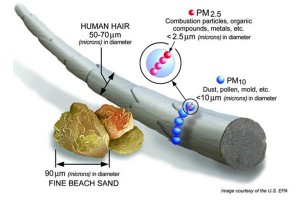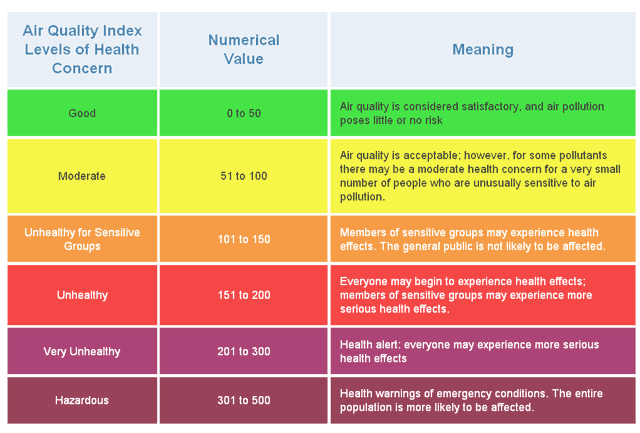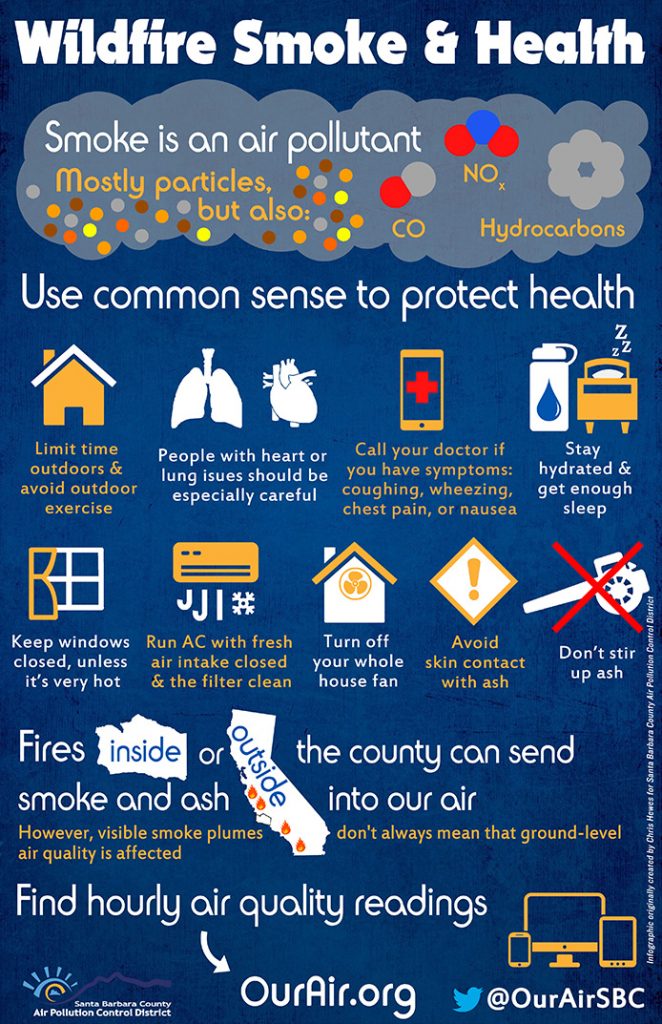Smoke primarily consists of particles and can include other gaseous air pollutants, including nitrogen oxides, carbon monoxide, and hydrocarbons that may be toxic. Exposure to smoke can cause health effects and make existing health conditions worse. Most healthy children and adults will recover from short-term smoke exposure. However, certain sensitive populations may experience more severe acute and chronic symptoms, and even healthy people may experience symptoms. Wildfires such as the 2017 Thomas Fire can produce unusually high concentrations of particles over an extended period of time. If you are experiencing symptoms, contact your doctor.
Particles 
Most smoke is a mix of very small liquid droplets and solid particles that become suspended in the air and can remain airborne for up to a week. When we talk about particle pollution, we are referring to inhalable “Particulate Matter” less than 10 microns in diameter (PM10, also known as coarse particles) and less than 2.5 microns in diameter (PM2.5, also known as fine particles ).
The invisible fine particles in smoke are of special concern because they can lodge deep into the lungs and cause serious health effects, such as aggravated asthma, nose and throat irritation, bronchitis and lung damage. Some particles may even get into your bloodstream and affect your heart. Visible dust and smoke and particles larger than 10 microns can also irritate your eyes, nose, and throat, but are less of a threat to your lungs and heart.
Who is at Risk
People with heart conditions or respiratory illnesses, children, and seniors are more sensitive to the effects of PM2.5, but it can affect everyone. People who spend extended periods of time outdoors without respiratory protection during days of poor air quality have increased risk of short and long term health effects. Exercise and physical activity also increase your risk because you breathe faster and more deeply and therefore take more particles into your lungs.
People with heart or lung diseases such as coronary artery disease, congestive heart failure, and asthma or chronic obstructive pulmonary disease (COPD) are at increased risk, because particles can aggravate these diseases. People with diabetes also may be at increased risk, possibly because they are more likely to have underlying cardiovascular disease.
Children have increased risk for several reasons: their lungs are still developing; they spend more time at high activity levels; and they are more likely to have asthma or acute respiratory diseases, which can be aggravated when particle levels are high.
Older adults are at increased risk, because they may have undiagnosed heart or lung disease or diabetes. Many studies show that when particle levels are high, older adults are more likely to be hospitalized, and some may die of aggravated heart or lung disease.
The higher the levels of particulates and the longer you are exposed to them, the more risk you have of experiencing symptoms and health effects. Things to consider are the number of days and levels of poor air quality, how much time you spend outdoors, your activity level, and the indoor air quality of your home.
Health Effects
Particles of these sizes can permanently lodge in the deepest and most sensitive areas of the lung, and can aggravate many respiratory illnesses including asthma, bronchitis, and emphysema. High levels of particle pollution have also been associated with a higher incidence of heart problems, including heart attacks.
The very fine particles can enter the bloodstream causing premature death in people with heart and lung disease. Health studies have shown that even short-term exposure to elevated levels of PM2.5 air pollution is associated with increased risk of heart attack and stroke. In addition, scientists are evaluating new studies that suggest that exposure to high particle levels may also be associated with low birth weight in infants, pre-term deliveries, and possibly fetal and infant deaths.
Symptoms
Most healthy children and adults will recover from short-term smoke exposure and will not suffer long-term health consequences. Certain sensitive populations may experience more severe acute and chronic symptoms. If you have specific health concerns, we encourage you to contact your doctor.
Smoke and ash can irritate the eyes, nose, throat and skin.
You may experience temporary symptoms such as; coughing; phlegm; chest tightness; and shortness of breath. Particulate matter may also affect the body’s physiological mechanisms that remove inhaled foreign materials from the lungs, such as pollen and bacteria. This can aggravate lung disease, causing asthma attacks and acute bronchitis, and may also increase susceptibility to respiratory infections.
If you have lung disease, you may not be able to breathe as deeply or as vigorously as normal, and you may experience coughing, chest discomfort, wheezing, shortness of breath, and unusual fatigue. If you have any of these symptoms, reduce your exposure to particles and follow your doctor’s advice. Contact your doctor if symptoms persist or worsen. If you have asthma, carefully follow your asthma management plan when particle levels are high.
In people with heart disease, short-term exposure has been linked to heart attacks and arrhythmias. Symptoms such as chest pain or tightness, palpitations, shortness of breath, or unusual fatigue may indicate a serious problem. If you have any of these symptoms, follow your doctor’s advice.
The cancer risk of short-term exposure to wildfire smoke is small relative to total lifetime exposures to carcinogens in other, more common combustion sources. Toxic materials and hazardous substances like asbestos are present in debris and ash from burned structures. People whose homes or businesses burned should consult with hazardous materials experts before clean up.
Reduce Your Risk
Check Today’s Air Quality for the most recent air quality in your area. See below to learn what the colors mean. Subscribe to air quality advisories but also use common sense. If it smells smoky outside, it’s not a good time for you or your children to exercise outdoors.
Stay indoors when particulate levels are high or wear a N-95 respirator mask. Reduce your physical activity and use caution when cleaning up ash. For more tips see Protect Yourself from Wildfire Smoke and Safe Ash Clean-Up During and After a Fire.
Fireplaces and woodstoves are an inefficient way to generate heat. They can turn a large part of your firewood into smoke instead of heat. Wood burns completely only at very high temperatures. Small, hot fires produce much less smoke, and are a much more efficient way to generate heat. You can increase the efficiency (and reduce the smoke production) of your fireplace or woodstove by doing some of the following:
- Switching to a gas fireplace
- Installing a fireplace insert
- Buying a new EPA-certified woodstove.
See also Tips for Cleaner Fireplace Burning and Wood Smoke Reduction Program.
Don’t add particle pollutants to your home by burning wood, gas logs, or even candles or incense. Limit the amount of ash you bring in from outside. Remove your shoes and wipe off your pet’s feet.
Consider purchasing an air cleaner for your home. Choose a high-efficiency (HEPA) mechanical filter or an electrostatic precipitator. Avoid using an air cleaner that works by generating ozone, which will increase the pollution in your home. The California Air Resources Board has information on selecting portable and central air cleaners– including information on choosing the correct size for your room(s). See Tips for choosing indoor air cleaner for effective indoor smoke removal in California. Open your windows and doors when air quality improves to get a clean exchange of air inside your home and car.
See also Indoor Air Quality and Health.
Burning typically releases particles and chemicals into the air. When trash is burned, including plastics, coated papers, and chemical products, additional cancer-causing pollutants and higher levels of particulate matter are released in the smoke. When furniture is burned (couches, chairs, mattresses), highly toxic substances can be released into the air, including hydrogen cyanide, acrolein, and ammonia.
Additional Resources
Wildfire Smoke and Ash
- Protect Yourself from Wildfire Smoke
- Safe Ash Clean Up
- Cleanup of Structures Damaged by Flooding and Fire
- California Smoke Information
- Air Quality Guidance Template for Schools
Smoke from Fireplaces and Woodstoves
- Tips for Cleaner Fireplace Burning
- Wood Smoke Reduction Program – Heat Clean, Save Green!
Other Sources of Smoke



